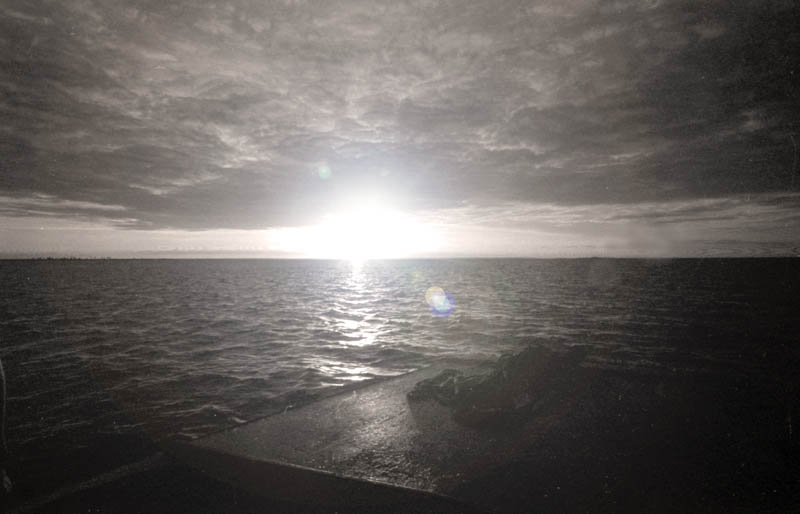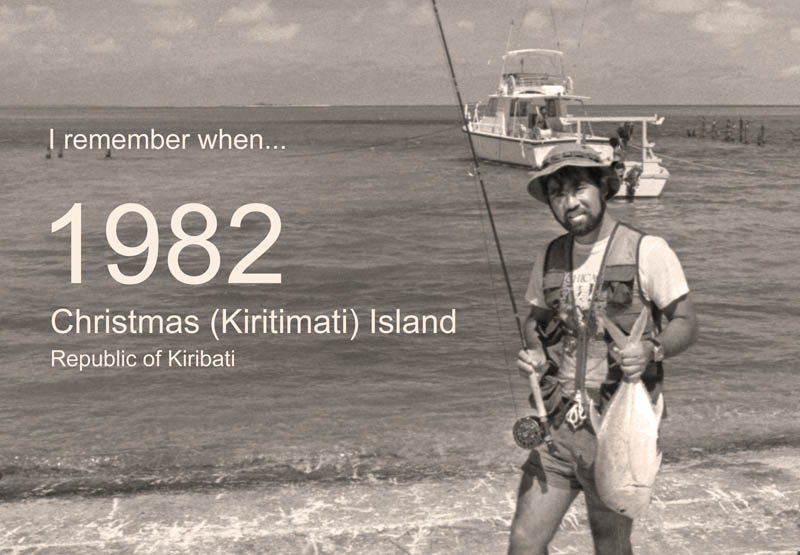
The spool was spinning furiously and the drag was making a metallic buzzing sound as the handle spun in a blur. I already had a pretty bad burn mark on my palm from trying to slow down the initial run and although I started out with over 200 yards of backing on the fly reel a few minutes ago, nearly all of it had disappeared into the clear blue water of the lagoon.
"Gone. It's gone," said Eric. I looked down into the reel and I could see the bottom of the spool with only a few wraps of backing left. The drag was locked down tight. Using a cotton glove soaked in sea water I clamped down hard on the spinning spool as a rubber coating that was supposed to cushion your hand as you palmed the reel began peeling off in chunks. I didn't know what was on the other end of the line but it was pissed at being hooked and was putting a serious bend on the rod. This was Christmas Island fishing at it's best.
Christmas Island, the largest coral atoll in the world, was named by Captain James Cook during his visit in December 1777. It remained nearly forgotten by most of the world until the 1850's when American phosphate companies came to mine the guano left by millions of sea birds and a New Zealand company attempted to harvest copra (dried coconut meat) for its oil. Both ventures were unsuccessful. In the 1880s the British incorporated Christmas Island and in 1919 it became part of the Gilbert and Ellice Island colony.
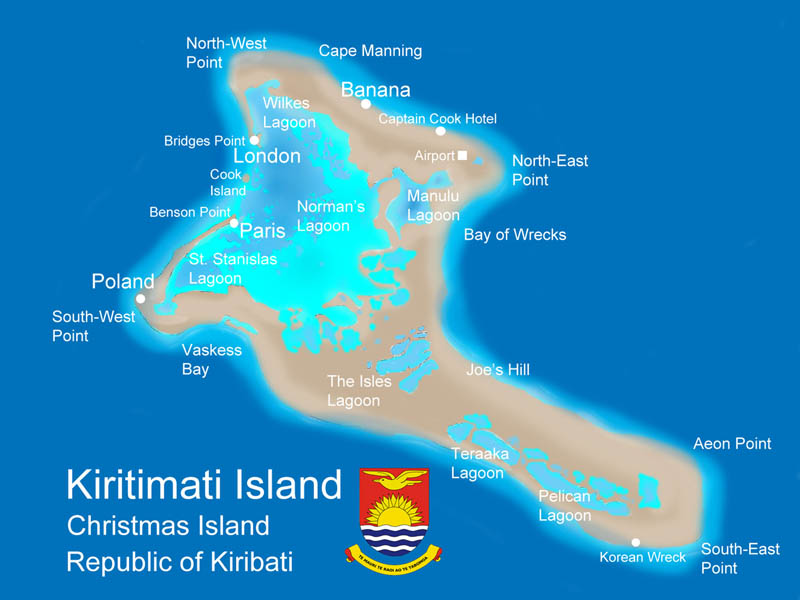
Christmas Island has several landmarks bearing unique names. In 1914 Frenchman Emmanual Rougier was granted a coconut plantation license and named his settlement Paris where he remained until the 1930s. The area known as Poland was named in honor of his Polish mechanic and the town of London was founded on the opposite side of the main channel leading into the Christmas Island lagoon.
In 1941 the British brought in workers from the Gilbert Islands to take over the plantations which formed the island's permanent settlement. After World War II the U.S. and British forces conducted high altitude hydrogen bomb tests between 1957 and 1962. A massive cleanup of Christmas Island, funded by the British between 2005 and 2006, have removed almost all visible traces of the nuclear tests and luckily there have been no long-term environmental effects due to radiation from the blasts.
The Gilbert Islands group attained independence from the British in 1979 and became the Republic of Kiribati, pronounced kirribas (kee ree bas--the local pronunciation of Gilbert). Recently Christmas Island has become the focus of an attempt to resettle almost 5,000 Kiribati islanders from the main island of Tarawa to control overcrowding.
I had fished Christmas Island since the late 70's with my brother and grandfather but this time our cousin accompanied us on the trip. This was also the first time I tried saltwater fly fishing. On previous trips I noticed other anglers staying at the Captain Cook Hotel, which was really just an old British Royal Air Force base, were there to fly fish and I was fascinated by the ability of these thin, fragile-looking rods to land a sizable fish. I grew up slinging heavy action spinners and baitcasters but this fly rod thing looked interesting and presented a challenge so I decided to try it out.
My biggest problem was finding gear. Al Gore didn't invent the internet yet and no fishing gear shop in Hawaii ever heard of fly fishing much less ever seen a fly rod, fly reel or fly line. Flies were something to be swatted off the picnic food. My good fishing buddy SteveL was game to try fly fishing too and eventually, with the help of a Bass Pro catalog, we were the proud owners of some fly fishing equipment. I had a very rough idea of what sort of gear I needed and wound up with a Daiwa multiplier reel (for every one revolution of the crank the spool would rotate 2.5 times--very fast line retrieval) a 2-piece high-tech graphite 7/8 weight rod and two Scientific Anglers weight-forward 8 weight floating lines, because the Christmas Island fly fishers said your line would get torn up before the week was over, and one Scientific Anglers 8 weight fast sink line to dredge the bottom. Now the only thing left to do was learn how to cast this stuff.
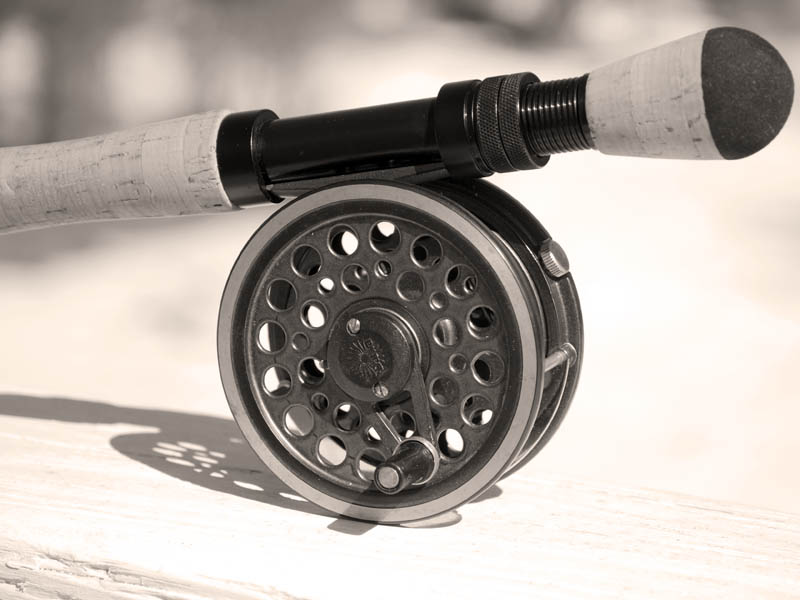
Daiwa multiplier reel. Each turn of the crank rotated the spool 2.5 times allowing rapid line retrieval.
We were on our own. I look back on this time as the beginning of all my bad casting habits. Steve and I probably owned the only two fly rods in Hawaii so as far as finding someone to teach us to cast we were out of luck. But Steve visited the public library and found a sports book that had a chapter that I will call "Fly Casting For Dummies", with illustrations on the proper 11 o'clock to 2 o'clock casting positions. That was it for our instruction. It was off to the Quarry pond to practice.
The Quarry pond is located on the lower campus of the University of Hawaii at Manoa near Cooke Field. Steve and I set up our gear and began to practice casting. It was very ugly at first but the delivery began to get a little smoother and soon we were able to get some line out. However after 45 minutes there was a slight jolt to the rod--the tip had exploded into a giant puff ball of graphite fibers. I called Bass Pro and the person on the other end said they had been having trouble with the 'new' graphite rods and what had happened is the tight wraps were suddenly unwrapping when the rod was flexing. They assured me that they would replace the rod but I was leaving for Christmas Island in two days and the rod wouldn't be here in time. But Steve, being a good fishing buddy, allowed me to take his rod instead.
I didn't use the fly rod for the first few days on the island and instead caught my fill of bonefish and trevally with my ultralight spinning outfit. In those days, and it's probably still true today, the flats were filled with huge schools of bonefish finning in the warm, shallow water. These fish weren't huge and it was normal to have 50-75 fish days on the flats. You would lay a cast out and 5-6 fish would immediately pounce, fighting among themselves to reach the lure first. The larger fish
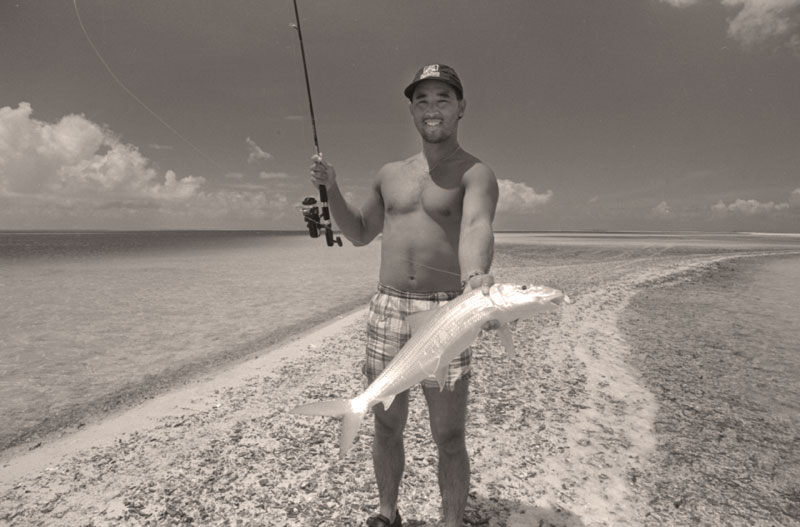
Eric with an average Christmas Island bonefish. On a productive flat, a 50-70 fish day was normal.
would be found closer to the reef edge but if you hooked one it immediately took off for the open sea, dragging your line through the sharp coral in an attempt to cut you off. Unfortunately this trick often worked and in the end you would be left with no fish, no lure and yards of shredded monofilament. However after a few days of countless fish you become sated and at that point I put down the spinner and picked up the fly rod.
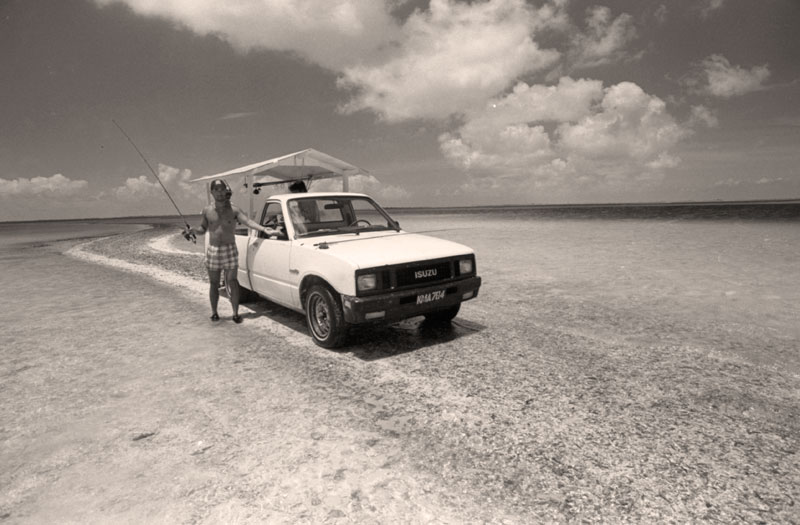
When the tide is in it's the end of the road. When you weren't fishing from a punt you were doing it from a rusty Isuzu pickup.
In the early days of Christmas Island fishing there were not enough punts, flat-bottomed fishing barges, to accommodate all the anglers so if you went out on a boat one day the next day you were shore fishing--tooling around to various secluded lagoons in a rusty Isuzu pickup truck with your guide. It was our turn to fish from the boat and I decided it would be a good time to use the fly rod. I had two spools for the reel, one loaded with a floating line and the other with the sinker so I was ready for whatever situation we might come across.
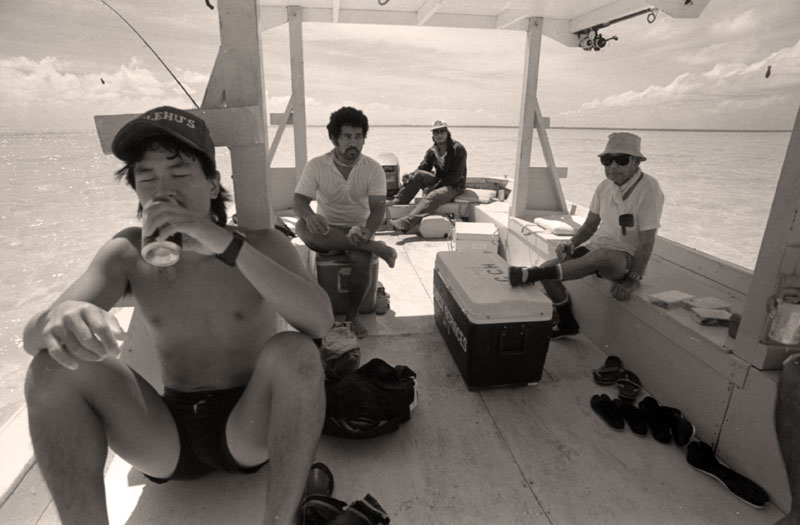
Early morning run across the lagoon from London to Paris.
We started out early in the morning, leaving the fishing port in London and motoring across the channel entrance towards Paris and St. Stanislaus Lagoon. The water was flat and calm and we passed a school of huge milkfish feeding on the surface. Our guide and boat operator said we'd be fishing the drop-offs at small sand islets that dot the lagoon so I swapped out the floating line for the sinking line then settled in for the one hour ride. We were fishing catch and release, but the boat operator and guide asked us if it would be okay to keep any fish that were gut or gill hooked for a feast the village was hosting the following day. We all agreed to their request because we usually averaged only one or two seriously hooked fish a day anyway.
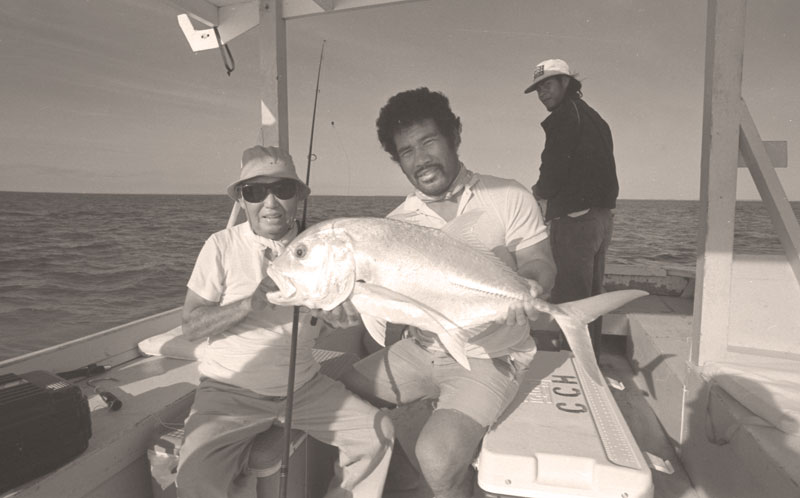
Big fish live here. My grandfather with a 40 pound trevally.
After setting the anchor firmly on the tiny sand island the boat was backed over the edge of the drop off. One moment you were looking at sand just a few feet below the boat and the next it was turquoise blue with no bottom in sight. Everyone threw a line in and soon the party was on. For the next two hours it was hookup after hookup, sometimes with all of us fighting a fish. We were in the middle of a school of medium to large jack and as one was being hauled to the boat three or four more were circling below waiting for a chance to take a crack at the lures being tossed from the boat.
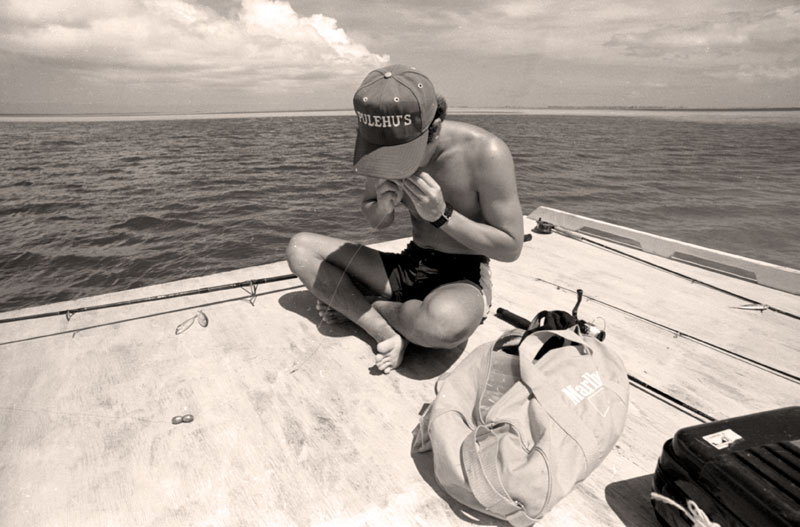
Getting ready for some heavy fishing. My cousin prepares his line during a break in the action.
I was shooting photos of the melee and finally decided to take a crack at a fish with the fly rod. I hesitated to use it at first because I still wasn't comfortable fishing with it and because I thought it was too flimsy to handle the large jacks circling below (and because it was Steve's rod). But I finally gave in and dropped the line into the water. I never saw the strike.
There was nothing tentative about the take. One moment I'm there, standing on the roof of the punt watching the line slowly sink, and the next second the rod is bent almost double and my hand is throbbing after the spinning reel handle busted my fingertips. I hung on as the line quickly peeled off the spool and moved off towards the horizon. I tried cranking the drag down and bottomed out the knob. I tried palming the spool, which had a coat of hard rubber laid over the aluminum rim to help provide more drag but all I managed to do was put a blister across my hand.
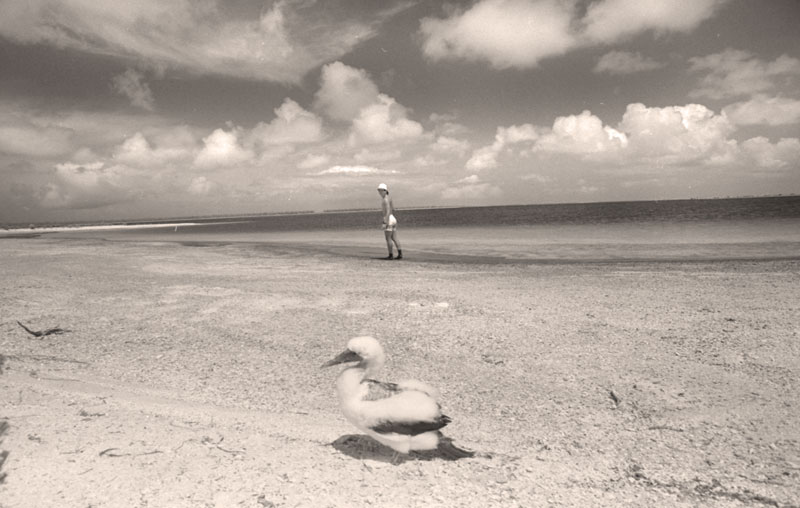
The constant screaming of the drag caught the attention of my brother and cousin and soon I had company although at the time I wished they stayed below, on deck, instead of watching me attempt to fly fish.
"Might be a big one," said my cousin. "I don't think you're going to catch it with that." More line disappeared from the spool.
My brother stood on my left shaking his head.
"You think you're going to catch that fish with this?", he said pointing to the bent fly rod. "You're going to bust Steve's rod. Cut the line. Cut the line. It's gone."
I used my t-shirt to add more pressure onto the spool. Bits of rubber began to flake off. Then I felt the heat from the spinning spool through the shirt. I asked my brother to soak a glove in water and I used that to palm the spool. It helped a lot, but the fish was still running hard and I could see I was almost out of backing so I really clamped down and big pieces of rubber began flying off. I was down to bare metal. There were only four wraps of line left when the fish stopped.
It took twenty minutes and two more runs, each shorter than the previous one, before the jack was brought to hand. It wasn't the biggest fish of the day but it was the most satisfying catch of the trip and my first on a fly rod.
The fishing continued to be hot for the rest of the day and we lost count of how many we landed and released. I continued to use the fly rod, caught lots of fish, and learned a lot about the tackle. By the time fishing was over and done, Steve's rod was still in pretty good shape but the fly reel spool looked like crap with most of the rubber palming rim missing and the paint job worn to bare metal in spots (note: I refinished the spool and still have it although it still looks like crap compared to the spare spool that I used in the photo above). And because the action was good the villagers got enough fish for their party.
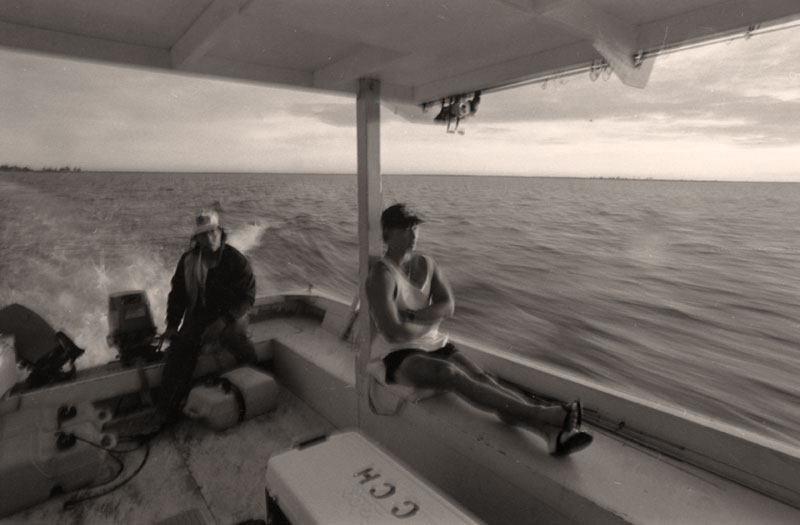
DIRECTIONS: Christmas Island is three hours due south by jet from Hawaii, about 115 miles north of the equator. There are now several hotels operating on the island and there are enough boats available to accommodate all anglers.
EQUIPMENT: You must bring multiples of everything. There is no fly shop or gear shop on the island. If it breaks and you don't have it, you're out of luck. On another trip I met a fly fisher that broke four of his seven rods on the first day (high-sticking). Rods from 7 to 9 weight for daily use. If you're after Giant Trevally then you need 10 to 12 weight rods. For open ocean fish use 14 to 16 weight rods. Bring extra fly lines, leaders and tippet. You will be shredded. Badly. Lots of Crazy Charlies and baitfish flies. Use sturdy saltwater specific reels that hold lots of backing and have a strong drag! I learned a painful lesson. The Daiwa multiplier worked great but the drag was totally insufficient to stop insane runs by pissed off fish.
